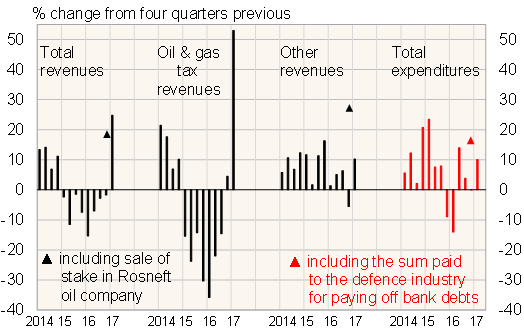BOFIT Weekly Review 16/2017
Russian federal budget revenues get a big boost from higher oil prices
Federal government revenues in the first quarter were much higher than in 1Q16. Revenues increased for the first time since late 2014 (i.e. before the fall in oil prices began to diminish government revenue streams). Revenues were also up in real terms from last year, but still far lower than in many previous years.
Most of the growth in revenues came from oil & gas tax revenues that jumped by one half from their bottom in 1Q16. The key driver was higher oil prices, which were up in dollar terms about 60 % y-o-y in the first quarter. On the other hand, the considerable on-year rise in the ruble's exchange rate limited the increase of oil & gas revenues in rubles (the taxes are essentially based on dollar pricing of oil & gas).
Other federal budget revenue streams also showed substantial gains in the first quarter that clearly outpaced inflation. Budget revenue streams from value-added taxes, which go entirely to the federal budget and are a major pillar of the federal budget's non-oil revenues, increased briskly. The same happened also with the rest of non-oil revenues.
Federal budget spending has increased quite moderately from its lows in early 2016, even with pensioners this year receiving their sizable one-time pay-out from the federal budget. In real terms, first-quarter spending was much lower than in several years preceding 2016. Defence spending fell markedly from 1Q16. On the other hand, at the end of last year the defence industry received a grand sum paid out from the budget for paying off a large part of their existing bank loans, which was aimed at creating more room for new borrowing by the defence industry.
Federal budget revenues and expenditures, 2014–2017

Sources: Russian Ministry of Finance and BOFIT.